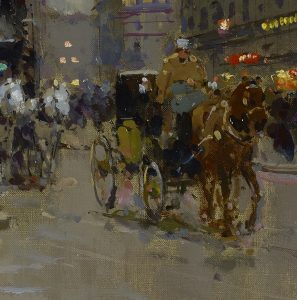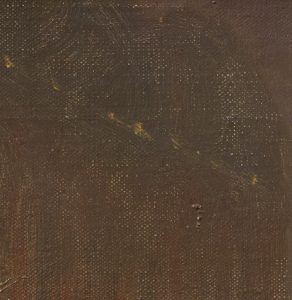This month I am going to touch on something I consider a pretty serious condition issue -- those bare spots on the canvas, or what is commonly referred to as ‘skinning’, ‘over cleaning’, or 'abrasion'.
To begin, we need to understand the difference between what an artist intended to do, and what someone else may have done.
Throughout time, artists used different techniques to create a work of art. Among these techniques is the removal of paint from a work in order to expose the base coat, ground, or canvas weave, to create a desired effect. Edouard Cortes (image below) was such an artist and when examining his paintings, you often find areas where the ground, or canvas, shows through. At times he used it to give body to the clouds, depth to the shadows, or a rainy appearance to the streets. There is nothing wrong with this and are as the artist intended them to be.
However, there are times where the ground or canvas is showing, and it was not done by the artist. In these cases, it is more than likely that the work has been ‘skinned’ or ‘over-cleaned’, leaving the areas abraded.
Before I go further, it is important to understand exactly what these terms mean and how this happens. When a competent conservator/restorer cleans a work of art, they use a variety of chemicals to remove the old finishing varnish (the uppermost layer of the painting that protects the paint surface). Before cleaning the entire work, they will test a few areas along the edge to see how the varnish and underlying pigments react to various chemical mixtures. After the proper mixtures are determined, they will slowly remove the finishing varnish. Knowledgeable and talented conservators understand the different drying times of pigments and what chemicals are normally safe for works from different periods; once cleaned, only the finishing varnish and any previous in-painting will be removed.
But what about all those individuals who fancy themselves conservators, but do not have the in-depth knowledge needed to safely clean works from different periods? A work in their hands can sustain damage. Remember that strong chemicals are used to clean a work of art and using mixtures that are safe for a 150-year-old painting might have disastrous results on a work that is only 50 years old … and vice-versa.
The terms ‘skinning’, ‘skinned’, ‘over-cleaned’, ‘over-cleaning’, and 'abraded' are used interchangeably to describe a condition where the original paint has been removed by someone other than the artist. This could be as minimal as removing a visually imperceptible amount of paint from the upper layers, to actually removing enough paint to expose the ground or canvas. Skinning can also happen to works that have never been restored … I am sure you are wondering: How is that possible? During my career, I have seen a number of paintings where a housekeeper used dust rags (which had furniture polish on them) to dust the front of a painting. Over time, these chemically soaked rags did ‘clean’ the painting … cleaning off areas of the original paint and skinning the work. Not a pretty sight.
Once a painting has been skinned, there are only two options … one is to leave the areas as they are, letting the skinned areas show (see the images in this article), or paint over the damaged areas, thereby covering them up in an attempt to return the work to its original look. Either way, depending on the extent of the damage, the value of the work may have been altered.
People often ask about a work’s condition; more specifically inquiring about the amount of in-painting. An honest individual will detail any condition issues that exist. But what we are seeing more and more of, especially with works that are being offered in the public forums, are paintings that have been skinned and not in-painted. You might ask – why? Well, if the damages are not in-painted, then the condition report will state that there is no in-painting. If there is no in-painting, then most people’s thoughts are that the work is in good condition … and this can be very deceptive because a work that displays extensive areas of over-cleaning, is not in good condition.
We all know that having a little knowledge can be dangerous … and when trying to determine a work’s condition this saying is never more fitting. As a buyer, you need to be conscious of all the subtle differences in the terminology utilized to describe a work’s condition. Aside from those already mentioned, others include ‘thinning’ and ‘thinned areas’; which are also used to denote over-cleaning.
As with any condition problem, the extent of the ‘over-cleaning’ (damage) will determine how much value, if any, has been lost. A painting with some minor skinning in the background areas, or in a relatively unimportant part of the painting might still be classified as in fine condition and there should be little change in the work’s value. On the other hand, if the central focus, or large areas, of the work has been skinned, then a detailed analysis of the damage needs to be made to determine how much value has been lost.
In the end, it is important to be aware that just because a condition report states that the work has little or no in-painting does not mean that it is in good condition. There is more to it than what is written on a piece of paper … at times, it is what is not written!



